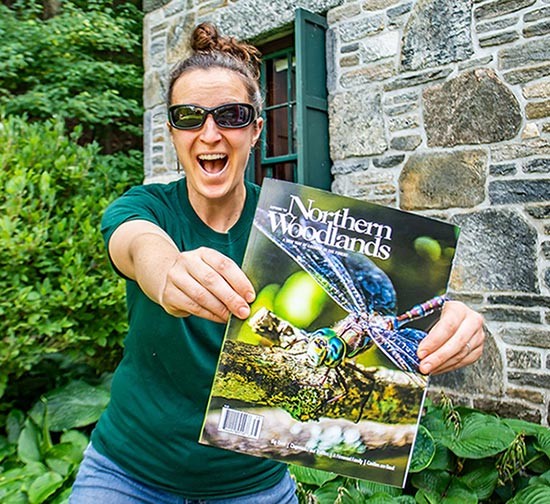Who’s in the woods? In this occasional web series, we check in with members of our tribe to learn a little bit more about the work they’re doing, the life they’re leading.
Tiffany Soukup and her husband Chris met in college and made a pact to “live a deliberate lifestyle” and see as much of the world as possible. So far, they’ve visited 40 different countries. In between trips, they’ve also worked at a number of Vermont state parks. Tiffany has written several articles for the Outside Story series, and the Autumn 2018 issue of Northern Woodlands magazine features one of her photographs on the cover.
Here are some excerpts from a recent interview:
Where did you grow up?
I grew up in the countryside of western New York, the Finger Lakes Region. It’s a lovely place full of rolling hills, dirt roads, cows, and those soft pink country sunsets you enjoy while sitting on a front porch. My sister and I were given a lot of freedom to run wild through our woods. It wasn’t all bliss … but that is largely how I began to explore what’s around me.
Describe some of your travels.
We lived in New Zealand for about a year and worked picking cherries and grapes. We also lived in Australia for almost two years. We bought a 1989 Mitsubishi Van and did the lap around the continent. We worked on a potato and sheep farm as well as in a cafe that was a dining car. Then we spent a year traveling around Southeast Asia. We visited many other countries in trips ranging from three to six months.
How were you able to afford this?
We made a lot of sacrifices early on and continue to make sacrifices to this day. When we were first starting out, we slept on a blow-up mattress, drove one car, ate a lot of pasta, and put every penny we could towards paying down our school loans. Becoming debt free early on helped us see the world.
How have your travels affected how you think about the Northeast?
When we travel, everything is so new and different...what type of tree is that? and so on. At home I’ve learned to try and apply the same level of excitement to things in my own backyard. This has led me to realize how little I actually know. After traveling to Africa for three months, I came back with inspiration to research and write about wild foods in the Northeast. The Outside Story article, Cattails: Nature’s Supermarket, is an example of this. Travel also helps me to see interconnectedness. For instance, I was so in awe when I first learned about pitcher plants in the Peacham Bog in Groton State Forest. Hop across an ocean and I was even more interested to know about the pitcher plants I was looking at in Borneo, Malaysia.
Do you plan to cook more cattails?
I have a friend who is very much into mushrooms and that has rubbed off on me. I harvested and ate some of my first wild mushrooms recently, without incident I can proudly add.
What are you doing now?
I am so thankful and pleased to say I have been living in a ferny forest at Townshend State Park for the past two summers. What we love about Townshend is it’s a quiet small park and we’ve had a lot of amphibian encounters here.
Tell us about that dragonfly cover shot.
Oh, the dragonfly shot. In the late summer dozens of dragonflies roam the sky here at the park. This one landed in the afternoon light on a lilac branch near the house. When I saw it resting, I raced back inside to get the camera. The dragonfly didn’t move and I was just so lucky to have a clear shot. When we travel, every little bug can seem new and exotic. This shot is a good example of how things at home can be just as exotic if we notice them.
What do you like about your work now? What's most challenging?
I play a direct role in taking care of a piece of land that is a shared home by both humans and wildlife. I love that. On top of that I have a start date and an end date. The most challenging part is leaving! Which I know doesn’t make any sense given my chosen lifestyle, but I get attached to places.
Through your work in state parks, you have many opportunities to interact with the public. Any thoughts on how to help people appreciate the outdoors/natural world?
To try and use the elements of surprise, excitement, and wonder. We are often at the office or shelter and will excitedly say, “do you know there are bats above us right now?” Then we will show guests the sleeping bats, and people are often so taken aback because they had no idea they were there. Following that we usually can find a red-backed salamander, garter snake, or some other herp...it’s a subtle way of showing that we are really sharing this space with animals, even if it might not always be completely obvious or realized.



Discussion *